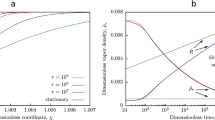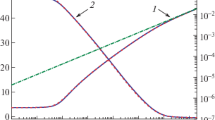Abstract
This paper presents analytical and numerical results of vapor bubble dynamics and acoustics in a variable pressure field. First, a classical model problem of bubble collapse due to sudden pressure increase is introduced. In this problem, the Rayleigh—Plesset equation is treated considering gas content, surface tension, and viscosity, displaying possible multiple expansion—compression cycles. Second, a similar investigation is conducted for the case when the bubble originates near the rounded leading edge of a thin and slightly curved foil at a small angle of attack. Mathematically the flow field around the foil is constructed using the method of matched asymptotic expansions. The outer flow past the hydrofoil is described by linear (small perturbations) theory, which furnishes closed-form solutions for any analytical foil. By stretching local coordinates inversely proportionally to the radius of curvature of the rounded leading edge, the inner flow problem is derived as that past a semi-infinite osculating parabola for any analytical foil with a rounded leading edge. Assuming that the pressure outside the bubble at any moment of time is equal to that at the corresponding point of the streamline, the dynamics problem of a vapor bubble is reduced to solving the Rayleigh-Plesset equation for the spherical bubble evolution in a time-dependent pressure field. For the case of bubble collapse in an adverse pressure field, the spectral parameters of the induced acoustic pressure impulses are determined similarly to equivalent triangular ones. The present analysis can be extended to 3D flows around wings and screw propellers. In this case, the outer expansion of the solution corresponds to a linear lifting surface theory, and the local inner flow remains quasi-2D in the planes normal to the planform contour of the leading edge of the wing (or screw propeller blade). Note that a typical bubble contraction time, ending up with its collapse, is very small compared to typical time of any variation in the flow. Therefore, the approach can also be applied to unsteady flow problems.
Similar content being viewed by others
References
Abbot IH, Von Doenhoff AE (1959) Theory of wing sections, including a summary of airfoil data. Dover Publications, Inc., New York
Ahn JW, Park II R, Park YH, Kim JI, Seol HS, Kim KS (2019) Influence of thru holes near leading edge of a model propeller on cavitation behavior. Journal of the Society of Naval Architects of Korea 56(3): 281–289. DOI: https://doi.org/10.3744/SNAK.2019.56.3.281
Benjamin TB, Ellis AT (1966) The collapse of cavitation bubbles and the pressures thereby produced against solid boundaries. Philosophical Transactions of the Royal Society B Biological Sciences, 260(1110): 221–240. DOI: https://doi.org/10.1098/rsta.1966.0046
Blake JR, Gibson DC (1987) Cavitation bubbles near boundaries. Ann. Rev. Fluid Mech. 19: 99–123
Brennen CE (1995) Cavitation and bubble dynamics. Oxford University Press, New York-Oxford
Briancon-Marjollet L, Franc JP, Michel JM (1988) Prediction of cavitation as a function of water nuclei content and hydrodynamic conditions (Case of the flow around a two-dimensional hydrofoil)
Ceccio SL, Brennen SE (1991) Observations of the dynamics and acoustics of travelling bubble cavitation. Journal of Fluid Mechanics 233: 633–660
Chahine GL (1976) Asymptotic study of the behavior of a cavitation bubble in a variable pressure field. Journal de Mecanique 15(2): 286–306
Chahine GL (2009) Numerical simulation of bubble flow interactions. Journal of Hydrodynamics 21(3): 316–332. DOI: https://doi.org/10.1016/S1001-6058(08)60152-3
Egashira R (2016) Effects of the translational motion of a vapor bubble on its expansion or contraction in cavitation inception. Proceedings of the Fluid Engineering Conference, 0723. DOI: https://doi.org/10.1299/jsmefed.2016.0723
Franc JP (2007) The Raleigh-Plesset equation: a simple and powerful tool to understand various aspects of cavitation. Fluid Dynamics of Cavitation and Cavitating Turbopumps, CISM Courses and Lectures, 496, Springer, pp1–41, 978321176682. DOI: https://doi.org/10.1007/978-3-211-76669-9_1, hal-00265882
Franc JP, Michel JM (2004) Fundamentals of cavitation. In: Fluid Mechanics and its Applications Series, Vol. 76, Kluwer Academic Publishers
Fuster D, Hauk G, Dopazo C (2009) Parametric analysis for a single collapsing bubble. Flow Turbulence and Combustion 82: 25–46. DOI: https://doi.org/10.1007/s10494-008-9169-8
Hsiao CN, Ma J, Chahine GL (2016) Numerical studies of bubble cloud dynamics near a rigid wall. Proceedings 31st Symposium on Naval Hydrodynamics, Monterey, USA
Iben U, Makhnov A, Schmidt A (2018) Numerical study of a vapor bubble collapse near a solid wall. Journal of Physics Conference Series 1135: 012096. DOI: https://doi.org/10.1088/1742-6596/1135/1/012096
Lauterborn W, Ohl CD (1997) The peculiar dynamics of cavitation bubbles. Applied Scientific Research 58: 63–76. DOI: https://doi.org/10.1023/A:1000759029871
Levkovskiy YL (1968) Pressure field caused by the collapse of the cavitation cavity. Acoustical Journal 14(4): 239–243. (in Russian)
Levkovskiy YL (1978) Structure of cavitating flows. Sudostroenie Publishers, Leningrad. (in Russian)
Lindau O, Lauterborn W (2000) Laser-produced cavitation-studied with 100million frames per second. AIP Conference Proceedings 524(1): 385. https://doi.org/10.1063/1.1309247
Miniovich IA, Pernik AD, Petrovskiy VS (1972) Hydrodynamic sources of noise. Sudostroenie Publishers, Leningrad. (in Russian)
Mishkevich VG, Rozhdestvensky KV (1978) Calculation of the flow past a thin hydrofoil on the basis of the method of matched expansions and its application for design of blade sections of screw propellers sections. Probl. S Shipbuild. Ser. Ship Des. 9: 96–106
Nigmatulin RI (1987) Dynamics of multiphase media. Part 1 (464 p.) and Part 2 (360 p.), Nauka Publishers, Moscow
Plesset MS (1949) The dynamics of cavitation bubbles. J. Appl. Mech. 16(3): 277–282. https://doi.org/10.1115/1.4009975
Plesset MS (1996) Shockwaves from cavity collapse. Philosophical Transactions of the Royal Society B Biological Sciences 260(1110): 241–244 DOI: https://doi.org/10.1098/rsta.1966.0047
Plesset MS, Chapman RB (1971) Collapse of initially spherical vapor cavity in the neighborhood of solid boundary. J. Fluid Mech. 47(2): 283–290. DOI: https://doi.org/10.1017/S0022112071001058
Prosperetti A (2017) Vapor bubbles. Annual Review of Fluid Mechanics 49: 221–248
Rayleigh L (1917) On the pressure developed in a liquid during the collapse of a spherical cavity. Phil. Mag. 34(200): 94–98.
Rusak Z (1994) Subsonic flow around the leading edge of a thin aerofoil with a parabolic nose. Eur. J. Appl. Math. 5: 283–311
Rusak Z, Morris WJ, Peles Y (2007) Prediction of leading-edge sheet cavitation inception on hydrofoils at low to moderate Reynolds number flows. Journal of Fluids Engineering 129(12): 1540–1546. DOI: https://doi.org/10.1115/1.2801350
Rozhdestvensky KV (1979) Method of matched asymptotic expansions in wing hydrodynamics. Sudostroenie Publishers, Leningrad. (in Russian)
Rozhdestvensky KV, Mishkevich VG (1983) Calculation of unsteady flow past a thin foil on the basis of the matched asymptotic expansions method. Journal “Issues of shipbuilding”, series “Ship design”, 37: 60–73. (in Russian)
Rozhdestvensky KV (2019) Study of unsteady flow near a rounded leading edge of a wing foil. J. of Marine Intellectual Technologies 1(43): 39–45. (in Russian)
Trummler T, Schmidt SJ, Adams N (2021a) Numerical investigation of non-condensable gas effect on vapor bubble collapse. Physics of Fluids 33(9): 096107. DOI: https://doi.org/10.1063/5.0062399
Trummler T, Schmidt SJ, Adams N (2021b) Effect of stand-off distance and spatial resolution on the pressure impact of near-wall vapor bubble collapses. International Journal of Multiphase Flow 141(1): 103618. DOI: https://doi.org/10.1016/j.ijmultiphaseflow.2021.103618
Van-Dyke MD (1955) Second-order subsonic airfoil-section theory and its practical application. NACA Technical Note 3390, Ames Aeronautical Laboratory, Moffett Field, California, Washington
Van-Dyke MD (1975) Perturbation methods in fluid mechanics. The Parabolic Press, Stanford
Van Rijsbergen M, Lidtke AK (2020) Sheet cavitation inception mechanism on a NACA 0015 hydrofoil. Proceedings of the 33rd Symposium on Naval Hydrodynamics, Osaka
Wang XY, Zhou SH, Shan ZM, Yin MG (2021) Investigation of cavitation bubble dynamics considering pressure fluctuation induced by slap forces. Mathematics 9(17): 2064. https://doi.org/10.3390/math9172064
Funding
Supported by the Ministry of Science and Higher Education of the Russian Federation as part of the World-class Research Center Program: Advanced Digital Technologies (contract No. 075-15-2020-903 dated 16.11.2020).
Author information
Authors and Affiliations
Corresponding author
Additional information
Article Highlights
• The pressure field around a thin foil with rounded leading edge is described with use of the method of matched asymptotic expansions.
• Dynamics of a vapor bubble moving along a flow streamline in immediate vicinity of the foil rounded leading edge is analyzed with use of Rayleigh-Plesset equation.
• Dynamics of a vapor bubble is analyzed in a range of variation of geometric and kinematic parameters for different foil families.
Rights and permissions
About this article
Cite this article
Rozhdestvensky, K.V. Dynamics of Vapor Bubble in a Variable Pressure Field. J. Marine. Sci. Appl. 21, 83–98 (2022). https://doi.org/10.1007/s11804-022-00289-4
Received:
Accepted:
Published:
Issue Date:
DOI: https://doi.org/10.1007/s11804-022-00289-4




